The unseen man-made ‘tracks’ on the deep ocean floor
At the base of the Pacific Ocean, hundreds of miles from land, there are some curious marks on the seafloor that no animal could have made. Some of them look like narrow troughs carved into the pale silt. Others could be claw marks, gouged through the ecosystems of the deep by an undersea monster.
Humanity has left many signatures on the surface of the Earth, but these long-lived features on the seafloor go largely unseen. Occasionally they are lit by the spotlights of remote submersibles, but afterwards they return to darkness. They have been there for decades. Like the footsteps and tracks that astronauts left on the Moon, they are still visible now, with nothing to wash them away.
The track pictured at the top of this article was 37 years old when it was photographed a few years ago, while the marks below date back to 1989.
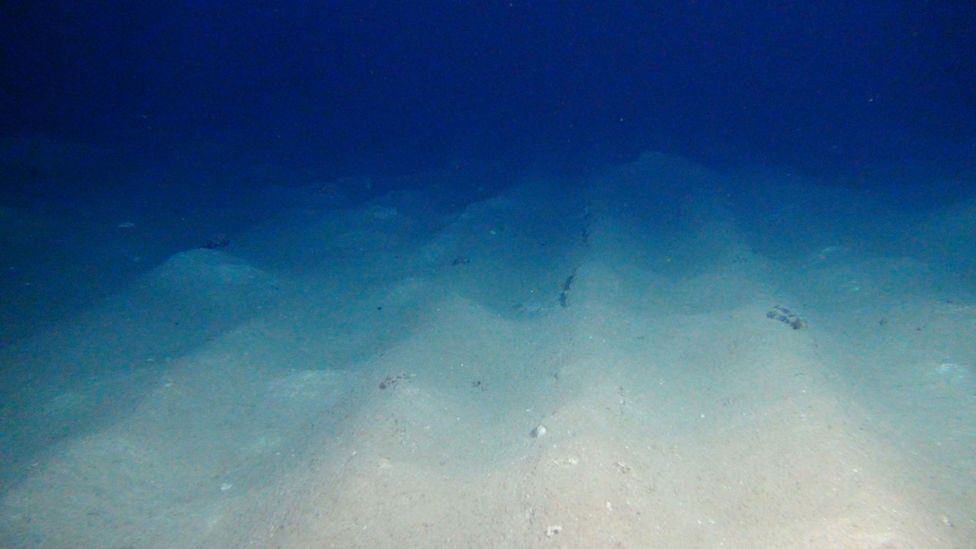
These deliberate marks in the seabed were 26 years old in this photo taken in 2015 (Credit: GEOMAR/MiningImpact Project)
Dating to the 1970s and 1980s, the marks are the first tentative scrapings of deep-sea mining trials, left behind by ships equipped with dredges and ploughs, now long since departed.
Recently, scientists have returned with cameras and probes to look at what has happened to the local ecosystems – and what they have found are scars that have never fully healed.
Soon, there will be many more tracks like these carved all over the ocean abyss, one of the last untouched wildernesses. What might future generations make of them, and what might they say about humanity’s demand for resources in the early 21st Century?
You may also like:
- Japan’s grand plan to mine deep-sea vents
- The secrets of the ocean floor
- The scarred landscapes created by humanity’s material thirst
To understand why these marks are there – and why they matter – we need to dive into a prehistoric sea.
One day, a shark shed a tooth, which drifted hundreds of metres to the ocean floor. Gradually, as metals precipitated out of the sea and water within the sediment, the tooth became coated in minerals. And so began one of the slowest geological phenomena on Earth: the growth of a polymetallic nodule.
Not all begin with a tooth – others contain fragment of shell, a bone shard, or nothing at all – but the slow pace of accretion is always the same. It takes them millions of years to grow only a few centimetres. But over time, they have become so abundant that they cover large swathes of the ocean’s abyssal plain.
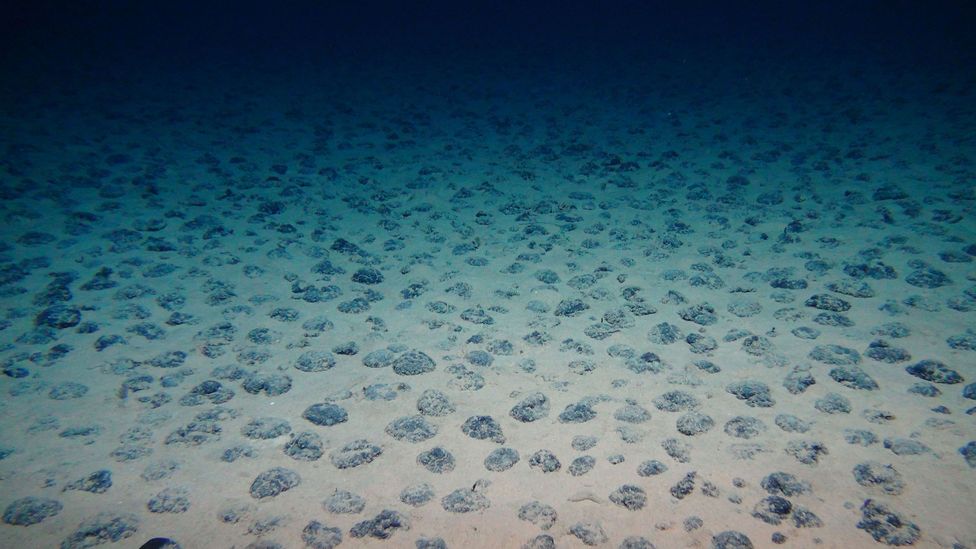
Polymetallic nodules in the south-east Pacific Ocean off Peru (Credit: GEOMAR/MiningImpact Project)
The nodules were discovered during the voyage of the HMS Challenger in 1873. When those sailors brought them to the surface, they would have grasped them in their hands like rocky potatoes, crumbling at the edges. To touch, they might have felt smoother on top, but rough on the underside, like pumice, where they had been growing into the surrounding sedimentary grains. If they’d held them to their nose, they’d have detected no scent.
The expedition’s chemist was one of the first to note that the nodules were not worthless. They were made of “manganese peroxide”, he wrote, which is “one of the principal substances used in the manufacture of bleaching powder”. Their remote location, however, meant “they could never be made a paying source of supply”.
Little did that chemist know how important they would turn out to be – to the organisms of the deep ocean, and later, to humans.
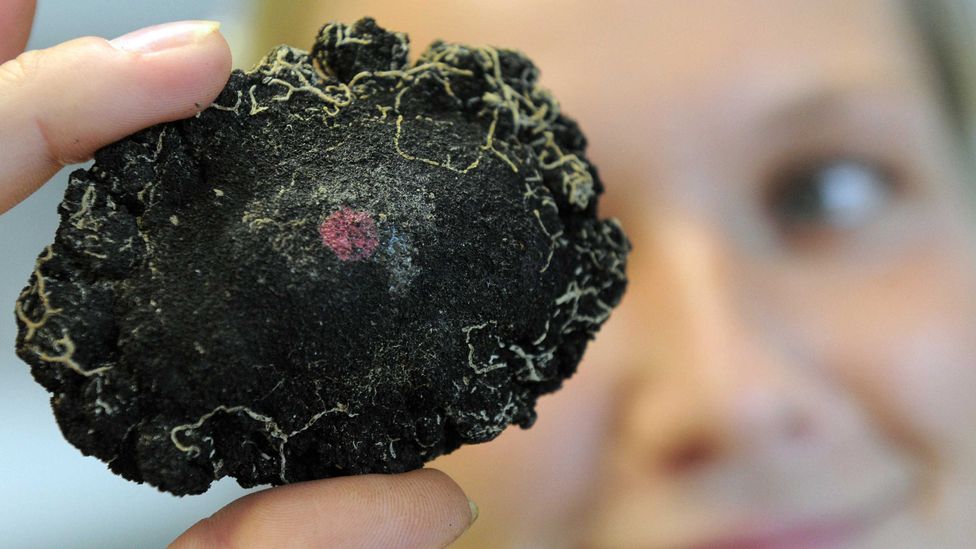
Polymetallic nodules were discovered in the 1800s, but remained only of scientific interest until recently (Credit: Alamy)
Years later, scientists would discover that these nodules are like islands for some forms of life. The abyssal plain on which they lie makes up 50% of the Earth’s surface – a sublime scale that can be difficult to imagine. If the oceans were suddenly removed, we would see that half our planet is a vast desert of loose sediment. Amid this barren plain, the nodules offer a rare, firm surface for life to cling to. Some sponges and molluscs are unique to them, while nematode worms and crustacean larvae have been found living within their crevices.
“They’re like the rocky areas in a garden – you’re going to have more species living there than you would if you only had soil,” says Daniel Jones of the National Oceanography Centre in Southampton, UK, who studies the effects of human interventions on deep-sea life.
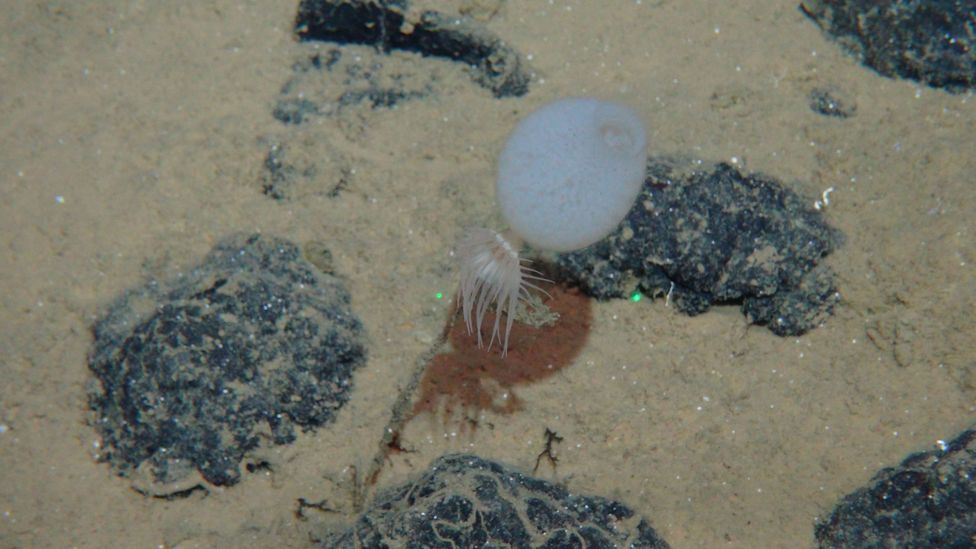
A sea anemone and sponge stalk attached to a polymetallic nodule (Credit: GEOMAR/MiningImpact Project)
Yet recently these nodules have also caught the eye of a rapacious land mammal, which needs them for their smartphones. What that expedition chemist in 1873 didn’t identify is that the nodules also contain metals, such as cobalt, nickel, copper, titanium and rare earth elements. These would one day present immense value to human beings.
As 21st Century technology surges, so too does the demand for its constituent materials, such as cobalt, which is used in lithium-ion batteries to power cars and electronics. The trouble is that, currently, much the stuff comes from problematic sources. The Democratic Republic of Congo extracts more than 60% of the global cobalt supply from land-based mines, but activity there has been linked to human rights abuses and child labour.
That makes oceanic nodules an increasingly appealing target, despite the daunting engineering challenges of getting to them. In one Pacific region – the Clarion Clipperton Zone (CCZ) – a conservative estimate suggests there are about 20 billion tonnes, if the nodules there were removed and dried out. While for decades they were considered uneconomic to exploit, a number of mining organisations are now mobilising to remove them, along with other types of subsea mineral deposit. If it goes ahead, hundreds of square kilometres per year will be dredged.
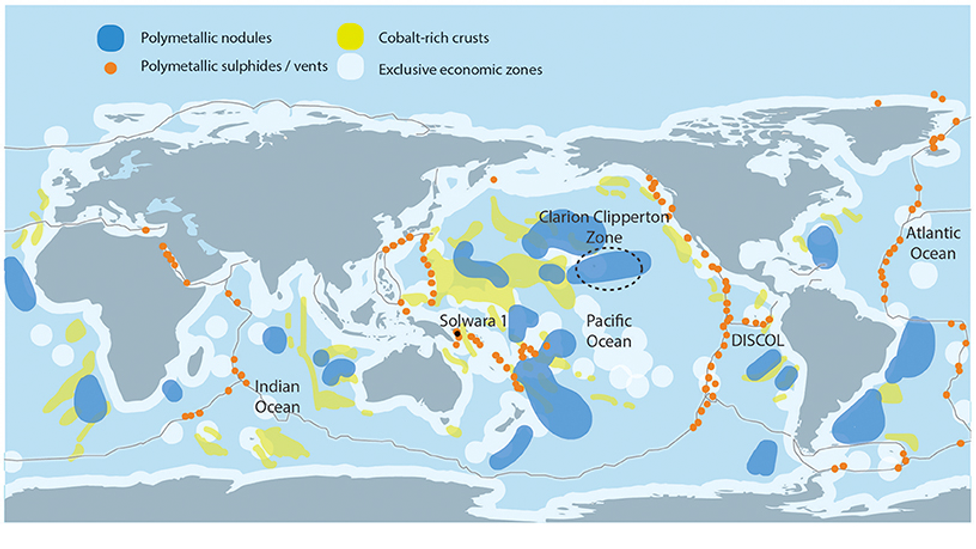
Locations of the three main types of marine mineral deposit, with polymetallic nodules in blue (Credit: Miller et al (2018), based on Hein et al (2013)/Andy Cole/CC BY 4.0)
What will the impact be? In the 1970s and 1980s, researchers and mining companies made the first tentative steps to assessing both the feasibility and environmental consequences. At various sites within the CCZ, as well as at another location near Peru called Discol (DIS-turbance and re-COL-onisation experiment), ships dragged specialised metal rakes and ploughs over the Pacific floor to scoop up the nodules and pull them to the surface. While it didn’t exactly mimic the dredging machinery planned for future mines, and the scale is much smaller, the effects provide some of the best evidence we have.
In some cases, the tracks were left behind by scientists curious about what would happen to an otherwise untouched ecosystem. At others, it was the nascent mining organisations themselves, testing their extraction technologies. One effort even involved the US’s Central Intelligence Agency (CIA). The Ocean Minerals Company (OMCO), a consortium of industry groups led by what is now Lockheed Martin, deployed test extractions on the Hughes Glomar Explorer. This ship would later gain fame for other reasons – it also carried a giant claw designed for a secret attempt to lift a Russian submarine off the seafloor.
If future generations one day find the tracks, they will have persisted long beyond the lifetime of the smartphone, laptop or electric car that helped to carve them
Years later, as plans for deep-sea mining have accelerated and exploratory permission opens up, researchers have returned to these locations in the Pacific to study the long-term effects. What they found is that, even after decades, life in these artificial trenches still hasn’t returned to normal. (Read more from the BBC about commercial deep-sea mining: “The secrets of the ocean floor“.)
On land, life tends to spring from the ploughed lines of a field, but in the deep sea the trenches are relatively barren. The creatures that relied on the nodules, now removed, cannot re-colonise. And others, which require soft sediment to burrow and find mobilised food, cannot live on the artificially compacted surfaces. “Communities of these nodule-bearing abyssal plains will be especially vulnerable to the risk of extinction brought about by the efforts to extract them,” concluded Lara Macheriotou of the University of Ghent and colleagues in a paper published earlier this year.
And it’s possible, say scientists, that such effects could linger for hundreds if not thousands of years.
Watch a submersible drifting over tracks on the ocean floor at the CCZ and Discol sites:
The sociologist Barbara Adam once proposed that the world can be thought of in terms of adjacent “timescapes”, which are characterised by their pace. She described how industrial or agricultural timescapes move at a much faster clip than natural and ecological ones. All these temporal regimes are interwoven, but when one is forced to move at the pace of another, long-term environmental damage becomes a risk.
The timescape of the deep ocean is slow and patient. So when humanity sends its machines down there to remove subsea materials, it is two different regimes of time colliding: the pace of an oceanic abyss versus a fast, short-termist desire for new technology.
The deep ocean couldn’t be further removed from the verdant ecosystems and accelerating societies of Earth’s landmasses. Temperatures on the abyssal plain hover close to freezing, the pressure is crushing, and there’s almost no light. The organisms that cling to life survive on a diet of “marine snow”. This continuous shower of organic detritus, often digested three or four times, rains down from above.
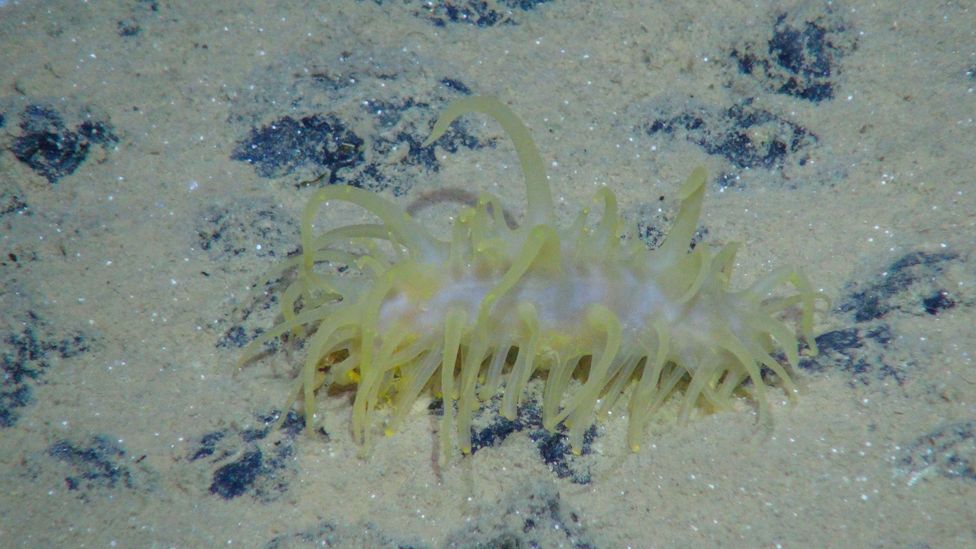
Unlike many other residents, sea cucumbers can move across the sediment surface (Credit: GEOMAR/MiningImpact Project)
“It’s a low temperature, low food, low energy environment, and this tends to set the pace of life,” says Jones. “The animals are not subject to the extremes of physical change you get in shallower waters. This is likely to be an area where any disturbance is long-lasting.”
But while these regions might seem like the deserts of the sea – certainly compared with the lively corals of shallow tropical waters – they are major reservoirs of biodiversity, and play a vital role in the carbon cycle via natural sequestration. “Many of the animals we see are new to science… and some organisms have pharmaceutically active compounds,” says Jones. Long-term, there’s also potential for interaction with fisheries higher up the water column. “There are functions performed by these communities that might not become valuable for centuries in some cases.”
We often can’t see the life within this vast space, because it’s too small and far too distributed to capture its scale with a photograph. There are no charismatic megafauna to put on a poster. But life exists there in overwhelming diversity, and it covers half our planet.
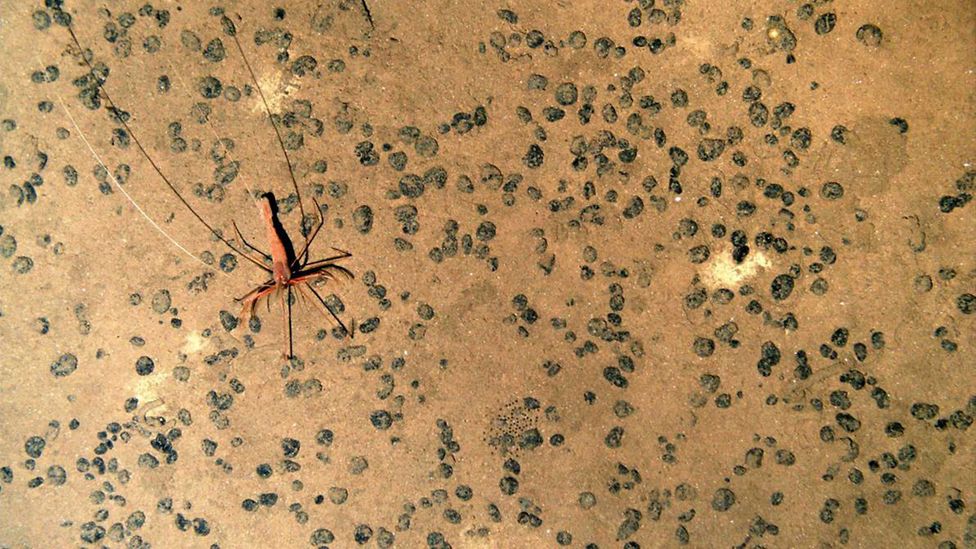
Larger creatures are rare in these environments (Credit: Daniel Jones)
Some might argue that damaging deep ocean life is a sacrifice worth making when weighed against human rights abuses at mines in Africa. Yet it is unlikely that one type of mining will simply displace the other, says David Santillo of Greenpeace Research Laboratories at the University of Exeter, who recently co-authored a review of seabed mining and its potential impacts in the journal Frontiers in Marine Science. “There are different companies involved, different markets to some extent, different demand-side pressures and incentives… so if seabed mining does take off, it is more likely that it will simply become an additional source of minerals.”
While the importance of deep-sea life may be difficult to quantify in human moral or economic terms, it does nonetheless have an intrinsic value. And the fact that its slow, long-term timescales are so quick to disrupt should be a reason for caution, according to the scientists I spoke with.
As for those dredged tracks, if future generations one day find them on the ocean floor, they will have persisted long beyond the lifetime of the smartphone, laptop or electric car that helped to carve them.
In the words of David Farrier, author of the book Footprints, such traces eventually become “future fossils”. In the age of the Anthropocene, Farrier argues that we are leaving behind unwanted industrial, chemical and geological heirlooms that will persist for centuries. “Future fossils are our legacy and therefore our opportunity to choose how we will be remembered,” he writes. “They will record whether we carried on heedlessly despite the dangers we knew to lie ahead, or whether we cared enough to change our course. Our footprints will reveal how we lived to anyone still around to discover them, hinting at the things we cherished or neglected, the journeys we made and the direction we chose to take.”
It’s possible the marks may well be read as a damning signature of our consumption habits in the early 21st Century. “If we are going to run out of certain minerals unless we destroy a large area of the seabed, then surely this is the signal to look again at how wasteful we are being with those minerals we have,” says Santillo. “If what we end up doing by mining the seabed is simply to extend unsustainable consumption patterns for another 30 years, or even accelerate them by bringing yet more materials to market… we won’t have changed anything.”
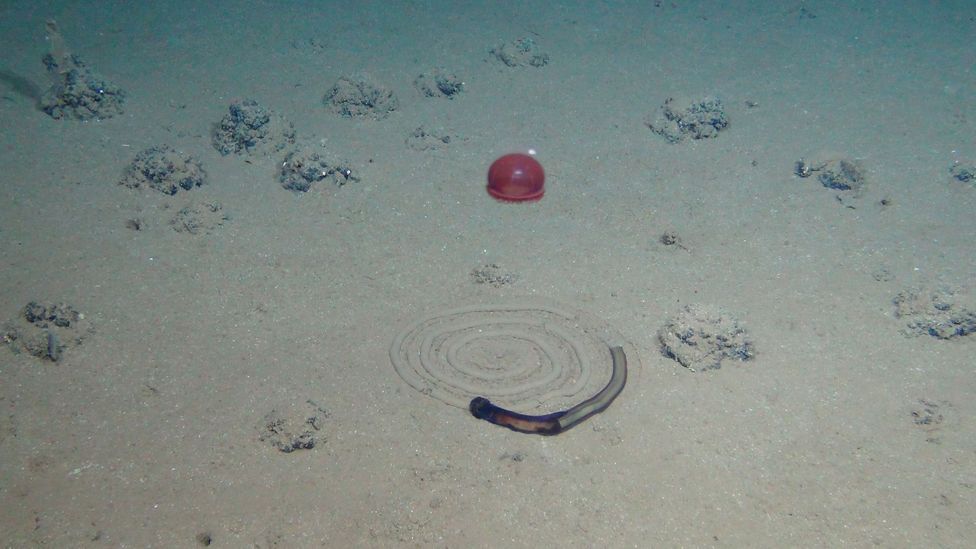
Another kind of track – a curious spiral left by a worm, as a jellyfish hovers above (Credit: GEOMAR/MiningImpact Project)
Sitting in London as I write this, my world is small and short-term, circumscribed by the restrictions of a UK lockdown and working from home. Yet more than anywhere in recent weeks, my mind has wandered back to the abyssal plain. In a time when many of the maps I look at nowadays plot the spread of the virus, here is a location on Earth that could not be further away from the pandemic.
Perhaps part of what draws me is the sheer extremity of this oceanic wilderness. I’ll probably never get to see it with my own eyes. Even the scientists who study it now use remote cameras, rather than descending to the seafloor themselves. The deep sea, and the life within it, has a scale that defies the imagination, both spatially and temporally. It is unaffected by what is happening on land – and this has been true for millennia.
Yet this may be the century where that changes; where we leave much more than one or two scrapings on the ocean floor. When researchers talk of human interventions in the deep sea, one word they often use is “disturbance”. In scientific language, it refers to a lofting and dispersal of sediment plumes, and the effects on subsea communities. But the word disturbance has another meaning – that of an irrational disorder.
By Richard Fisher for BBC Future.



